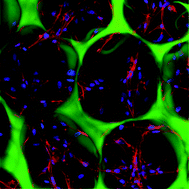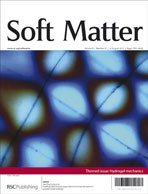The mechanical properties of the microenvironment are being recognized as a key contributor to stem cell behaviour, whether in the context of tissues or when designing biomaterials. While there has been considerable evidence demonstrating the effect of 2-D static mechanics on stem cells, few systems exist to investigate the influence of the 3-D presentation of mechanical signals. In this study, methacrylated hyaluronic acid (MeHA) was processed into porous (crosslinking around spherical templates) 3-D hydrogels with tunable elastic moduli ranging from ∼1.5 kPa to 12.4 kPa. Porous hydrogels were fabricated with a sequential crosslinking process (addition crosslinking of methacrylates with dithiols, followed by UV photopolymerization) where the hydrogel mechanics are controlled by the extent of UV exposure and are subsequently seeded with human mesenchymal stem cells (hMSCs). hMSCs spread within the pores and proliferated in a mechanically dependent manner as cells within the softest 1.5 kPa hydrogels were less spread initially and showed little proliferation with time, while hMSCs in stiffer hydrogels (>1.5 kPa) had higher initial spreading and a roughly two-fold increase in cell number after 14 days. In growth media, porous hydrogels supported a slight upregulation (two to eight-fold) in chondrogenic genes across all mechanics, while there was only modest upregulation in a few conditions (and in many cases downregulation) for myogenic, osteogenic, and adipogenic genes. The secretion of various cytokines and angiogenic molecules was found to be mechanically dependent in the porous system with greater secretion at day 2 in the stiffer hydrogels (3.8 kPa and 7.4 kPa). However, by day 14 there was greater secretion in the softer hydrogels (1.5 kPa and 2.6 kPa). Finally, when mechanics were temporally increased during culture (from ∼2.6 kPa to 12.4 kPa), there was a noticeable decrease in the secretion of 15 angiogenic and cytokine proteins. Thus, the influence of mechanics on stem cells within hydrogel structures appears to be dependent on the magnitude and timing of presentation.

You have access to this article
 Please wait while we load your content...
Something went wrong. Try again?
Please wait while we load your content...
Something went wrong. Try again?


 Please wait while we load your content...
Please wait while we load your content...